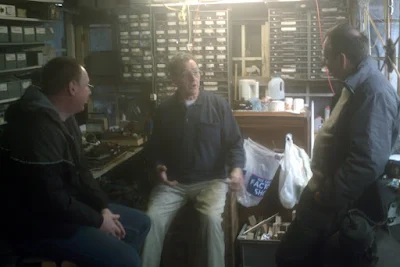Tools Explained
DRILL PRESS : A tall upright machine useful for suddenly snatching flat metal bar stock out of your hands so that it smacks you in the chest and flings your beer across the room, denting the freshly-painted project which you had carefully set in the corner where nothing could get to it.
WIRE WHEEL : Cleans paint off bolts and then throws them somewhere under the workbench with the speed of light. Also removes fingerprints and hard-earned calluses from fingers in about the time it takes you to say, "Oh, shit!"
SKILL SAW : A portable cutting tool used to make studs too short.
PLIERS : Used to round off bolt heads. Sometimes used in the creation of blood-blisters.
BELT SANDER : An electric sanding tool commonly used to convert minor touch-up jobs into major refinishing jobs.
HACKSAW : One of a family of cutting tools built on the Ouija board principle. It transforms human energy into a crooked, unpredictable motion, and the more you attempt to influence its course, the more dismal your future becomes.
VISE-GRIPS : Generally used after pliers to completely round off bolt heads. If nothing else is available, they can also be used to transfer intense welding heat to the palm of your hand.
OXYACETYLENE TORCH : Used almost entirely for lighting various flammable objects in your shop on fire. Also handy for igniting the grease inside the wheel hub out of which you want to remove a bearing race.
TABLE SAW : A large stationary power tool commonly used to launch wood projectiles for testing wall integrity.
HYDRAULIC FLOOR JACK : Used for lowering an automobile to the ground after you have installed your new brake shoes, trapping the jack handle firmly under the bumper.
BAND SAW : A large stationary power saw primarily used by most shops to cut good aluminum sheet into smaller pieces that more easily fit into the trash can after you cut on the inside of the line instead of the outside edge.
TWO-TON ENGINE HOIST : A tool for testing the maximum tensile strength of everything you forgot to disconnect.
PHILLIPS SCREWDRIVER : Normally used to stab the vacuum seals under lids or for opening old-style paper-and-tin oil cans and splashing oil on your shirt; but can also be used, as the name implies, to strip out Phillips screw heads.
STRAIGHT SCREWDRIVER : A tool for opening paint cans. Sometimes used to convert common slotted screws into non-removable screws and butchering your palms.
PRY BAR : A tool used to crumple the metal surrounding that clip or bracket you needed to remove in order to replace a 50 cent part.
HOSE CUTTER : A tool used to make hoses too short.
HAMMER : Originally employed as a weapon of war, the hammer nowadays is used as a kind of divining rod to locate the most expensive parts adjacent to the object we are trying to hit.
UTILITY KNIFE : Used to open and slice through the contents of cardboard cartons delivered to your front door; works particularly well on contents such as seats, vinyl records, liquids in plastic bottles, collector magazines, refund checks, and rubber or plastic parts. Especially useful for slicing work clothes, but only while in use.
Son of a bitch TOOL : Any handy tool that you grab and throw across the garage while yelling, "Son of a bitch" at the top of your lungs. It is also, most often, the next tool that you will need.
No trees were killed in the sending of this message.
However, a large number of electrons were terribly inconvenienced

My workshop is a black hole.
ReplyDelete73 from somewhere beyond the event horizon,
Steve Smith WB6TNL
"Snort Rosin"
In addition to black holes, my "bench" has uni-directional time and space "worm holes" which transport missing objects from bench to "Rat Shak" where they relocate in bubble packs. In order to reverse the flow back to bench, a tariff or toll fee is charged by Rat Shak. Most commonly "worm-holed" objects are leaded component side-cutters, solder and electrical tape. That's the extent of worm-holed objects. The rest, the irreplaceable objects, are black-holed.
ReplyDeleteGil
Blow me down! I've got one of those keys and didn't realise what it was.
ReplyDeleteThanks
Dave, G4OMN
While it might be observed that microscopic black holes, could well be the reason for the disappearance of tools, components and the all important EMRFD.
ReplyDeleteThe role of the quantum dispersion cannot be dismissed
, Using wavepacket states. It is shown that the expected position of the object
in the momentum correlation function is obliterated by the dispersion of the localized states, and therefore becomes unobservable.
This is also an observed side effect of Quantum Tunnelling (AKA Tunnel vision)
and is experienced when looking for everyday objects such as car keys etc...